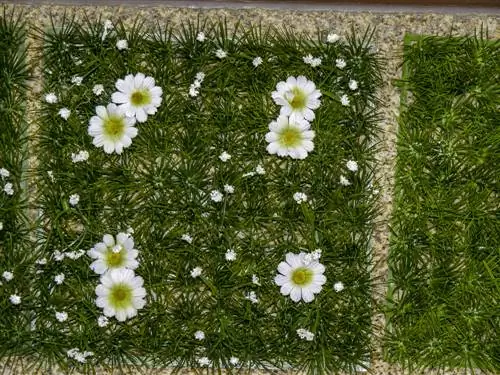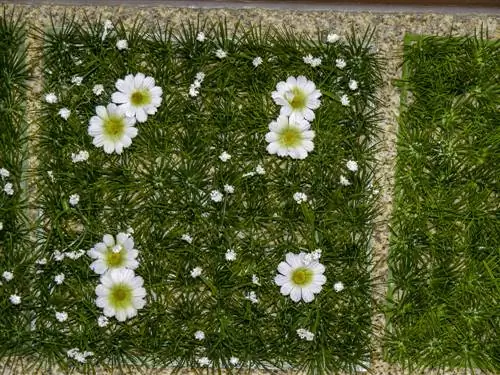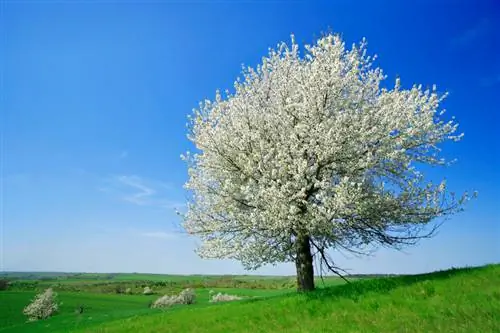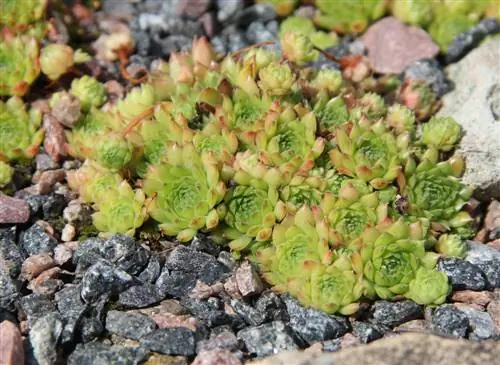- Author admin [email protected].
- Public 2023-12-16 16:46.
- Last modified 2025-06-01 06:02.
Is complex lawn care getting too much for you? Then artificial turf in the garden is a sensible alternative. Mowing, fertilizing, scarifying and spraying are a thing of the past. However, artificial turf is not the Holy Grail of garden design. This guide highlights all the advantages and disadvantages with practical tips for installation.

What are the advantages and disadvantages of artificial grass in the garden?
Artificial grass in the garden offers advantages such as easy-care green, long service life and uncomplicated application. Disadvantages include acquisition costs, susceptibility to contamination and flammability. The installation includes floor preparation, geo-fleece installation and attachment of the artificial turf.
Artificial turf put to the test - advantages and disadvantages at a glance
Top cared for, real lawn is a feast for the eyes. However, moles, weeds, moss and constant rain often thwart the diligent gardener's plans. Not to mention the time-consuming care program. Artificial turf puts an end to these inconveniences. The high-tech green is still not the ultimate because there are disadvantages. We have compiled the most important pros and cons for you below:
Advantages:
- perfectly imitates real grass
- for all sunny, partially shaded and shady locations
- no more watering, mowing, fertilizing, scarifying
- ideal as a playground for young and old
- Swimming pool can remain standing
- Lifespan up to 15 years
- made from harmless polypropylene (PP) and polyethylene (PE)
- positive environmental balance
Disadvantages:
- expensive to buy
- sensitive to dirt
- flammable, therefore not suitable for barbecue parties
- Cheap products not suitable for walking barefoot
Artificial grass for the garden - price examples
The financial aspect is considered the biggest inhibition when making the decision between real turf and artificial turf. If you lay the artificial greenery yourself and lower your requirements a little, you can still cover the costs. The following table provides an overview of the range in the cost structure:
| Artificial grass | Height | Price per m² |
|---|---|---|
| for camping and balcony | 9mm | 9, 95 euros |
| Play turf | 30mm | 29, 95 euros |
| ornamental lawn | 35mm | 34, 95 euros |
| Premium quality | 36mm | 49, 95 euros |
New on the market is artificial turf made from C-shape yarn. The particular advantage is that it retains its shape, so you can leave your children's swimming pool on these surfaces all summer long. With a product height of 32 mm, C-shape artificial turf costs 32.95 euros per square meter.
Laying artificial turf yourself - a quick guide
First, the old sod is completely removed and the area is straightened with topsoil. Create a sand bed about 10 cm thick from paving sand, which you moisten, roll and smooth. Proceed as follows:
- Spread geowoven fabric on the sand and fix it with anchors
- Roll out the artificial turf and smooth it out
- Fix the surface with artificial turf anchors at a distance of 50 cm
- When laying with seams: fold over both sides and cut off a 3 cm wide edge
- Lay special artificial turf tape (€20.00 on Amazon), knock back the lawn and press it on
- Cut off any excess edges with a utility knife
Finally, brush the lawn thoroughly with a hard broom.
Tip
As an outdoor covering for your self-built garden sauna, artificial turf is a decorative and easy-care option as an outdoor covering. Compared to natural stone paving, the artificial green is also a cost-effective alternative for setting up loungers or a small pool.






